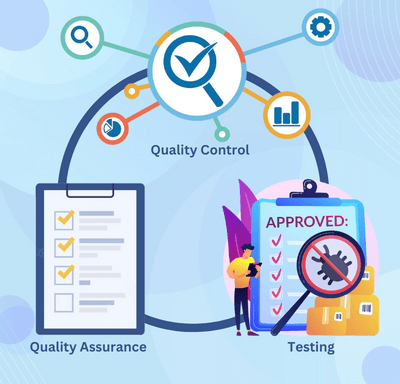
About us
Our Services
Our Expertise
Our Experience
Follow us
Why e2logy?
- We strive to provide superior customer service and ensure that every client is completely satisfied with our work.
- Our engineers are trustworthy, dedicated, and experienced and will go the extra mile to solve your IT issues.
- We are committed to delivering outstanding, cutting-edge IT solutions that add real value that goes beyond what is expected.

Quality Assurance (QA), Quality Control and Testing

The terms used by organizations are often interchangeable, even when they aren’t equal.
The IT industry is likely to have encountered them at some point. In addition, many executives – as well as customers – don’t fully understand the difference between these terms. These processes are not identical, and they’re usually referred to as such. It is important for software managers to understand the differences between these three approaches to effectively manage the risks associated with software development and maintenance. Let’s see what’s the difference.
An Overview of Software Quality: Quality Assurance (QA), Quality Control (QC), and Testing
Humans are capable of erring, but sometimes the costs of mistakes are too high. The effects of software flaws have been numerous throughout history, ranging from Starbucks’ register malfunction that led to free drinks to the radar malfunction in the F-35 military plane that prevented it from accurately detecting targets.
The concept of software quality was developed to ensure that software releases are safe and function as expected. In many cases, it can be defined as “the degree of conformance to explicit or implicit expectations and requirements”. There are two basic levels of software quality, referred to as explicit and implicit expectations:
Functional: The product conforms to specifications and functional requirements (explicit or implicit). As a practical aspect, this aspect is concerned with the functionality, performance, ease of use, and defect-free nature of software from the perspective of the user.
Non-Functional: Structure (implicit) requirements of the system, i.e. its inner characteristics and architecture. A code must be maintainable, understandable, efficient, and secure.
Code reviews, analysis, and refactoring are the most common ways to ensure the structural quality of software. It largely depends on the engineering team’s expertise. Quality assurance, quality control, and testing are some of the activities that contribute to the functional aspects of quality management.
In software quality management, these three terms are often used interchangeably, but each refers to a different aspect. They share the goal of producing a product of the highest quality, functionally and structurally, but they approach it differently.
The difference between Quality Assurance (QA), Quality Control (QC), and Testing
Quality assurance (QA), quality control (QC), and testing are often confused by people and organizations. Although they share many similarities, they are quite different from one another. Software managers must understand the differences between all three to effectively manage the risks associated with the development and maintenance of software. Below is a description of each:
What is Quality Assurance (QA)
Processes are central to quality assurance. Preventing defects has everything to do with managing and creating deliverables in a way that works. Team members follow it consistently not only because it works, but also because it is effective. In quality assurance (QA), efficiency and effectiveness are the goals.
There is no guarantee that a defect will not return if it is found and fixed. QA is responsible for identifying the process that allowed the error to occur and re-engineering the system to prevent such errors from recurring. In QA, the product is tested to ensure that it continues to meet the customer’s expectations.
Quality assurance is more important than quality control. Fixing bugs becomes expensive at the QC stage, for example. It is therefore extremely valuable for organizations to invest in improving quality assurance processes.
In quality assurance, processes are defined and implemented, training is provided, audits are conducted, and tools are selected.
What is Quality Control
The purpose of quality control is to detect problems before a product is launched and during production. This ensures that the deliverables meet the organization’s quality standards and specifications. Testing, code reviews, peer reviews, and other aspects of QC are often part of the quality assurance process.
To ensure that applications are bug-free and meet specifications, QC is crucial, but it might not be the best option for every situation. It is here that Quality Assurance comes into play. Despite its importance, even the most experienced professionals often misunderstand it.
What is Testing?
Quality control includes testing. Detecting and rectifying bugs in a product through the execution of a system. The goal of QC is to ensure a product’s design and performance match expectations. Testing is a vital component of this process.
All things should be viewed as assembly lines. An assembly line’s quality assurance process can be compared to its quality control process, which involves checking the assembly line’s products to make sure they meet the requirements.
An effective product requires both quality assurance and quality control. Inefficient processes and bugs in the product can be detected when they are combined. In addition, QA and QC can contribute to the development and delivery of high-quality products.
Summing Up
To summarize, Quality Assurance ensures that the correct processes are in place to produce quality products. Establishing Quality Control Processes is also important. Testing is one of the processes that are made sure to be followed during Quality Control.
Testers and quality assurance engineers are typically expected to know the basic concepts of quality assurance, quality control, and testing. An automation tester needs to learn these skills once they are familiar with end-to-end testing and are involved in the end-to-end testing of software.













